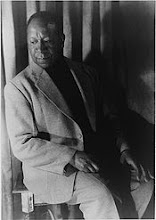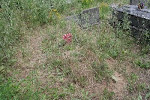Duke University Press describes Amy J. Elias' Speculative Light: The Arts of Beauford Delaney and James Baldwin (2025) as a publication that "brings together scholars, critics, and artists who analyze the stylistic and historical import of Delaney's and Baldwin’s works and examine how this friendship fundamentally shaped the pair's ideas about art and life.
"The book’s contributors explore how the two men, sharing identities as queer Black American artists, first in New York and then as expatriates in France, created a speculative space in their work to think about more just and creative Black futures."
Cover Art: Portrait of James Baldwin
(1965) Oil on canvas
Chrysler Museum of Art, Norfolk, VA
© Estate of Beauford Delaney
by permission of Derek L. Spratley, Esquire
Court Appointed Administrator
Courtesy of Michael Rosenfeld Gallery LLC, New York, NY
Dr. Elias, who is Chancellor’s Professor, Distinguished Professor of English, and Director of the Denbo Center for Humanities and the Arts at the University of Tennessee, Knoxville, organized the February 2020 symposium of the same name in parallel with the opening days of the Beauford Delaney and James Baldwin: Through the Unusual Door exhibition at the Knoxville Museum of Art.
Scholarly papers presented at the symposium responded to questions concerning arts history and Black aesthetics, music and sonic arts, ethics and social values, style and form, gender and sexuality, and biography and legacies. Elias gathered these extraordinary papers and assembled them for the Duke University Press publication.
Speculative Light is both broad and deep in its exploration of Beauford and Baldwin. "Casual" readers should understand that the writings are indeed scholarly and that this is not a book that can be readily skimmed for information.
Rather than write a review of the entire collection of essays in a single post, I have decided to select elements of Beauford's life and work that are discussed by multiple contributors and present a few of their thoughts—ranging from painterly descriptions to psychological inferences—about these elements in periodic blog posts.
Today, I present various musings about Beauford's first portrait of Baldwin: Dark Rapture.
(1941) Oil on masonite
Collection of halley k harrisburg and Michael Rosenfeld, New York
© Estate of Beauford Delaney
by permission of Derek L. Spratley, Esquire,
Court Appointed Administrator
Courtesy of Michael Rosenfeld Gallery LLC, New York, NY
This painting is presented on the first of 32 color plates that illustrate Speculative Light.
The book's first mention of Dark Rapture comes from Beauford's biographer, David Leeming.1
In his essay entitled "Jimmy and Beauford—The Bond of the Unusual Door," Leeming expresses his belief that the title of the work may have been inspired by the 1938 documentary (the text erroneously says "1931") about explorations of the Belgian Congo. He describes Dark Rapture as "an act of love, like nothing he had painted before or would ever paint again."
Discussions about the painting itself begin with Magdalena J. Zaborowska's2 essay, "Beauford Delaney's Black Queer Fatherhood."
Zaborowska describes Beauford as an alternative father figure that Baldwin desperately needed. She says Baldwin's features seem "undefined" and interprets the portrait as capturing "the psychic toll exacted by the youth's Harlem preacher father" and "the painful impact of Baldwin's homophobic and violent stepfather."
She comments that this portrait is unique because Beauford focused on Baldwin's "darkly luminous" body rather than his "expressive face," and she construes Baldwin's posture as a reflection of "indecisiveness and slight physical discomfort."
Zaborowska goes on to say that "Baldwin is rendered motionless yet dynamic, sparkling with light and energy, yet afraid and uncertain." She states that Baldwin, "in Delaney's eye, is both a wounded child and an erotically charged demigod . . . ."
(1941) Oil on masonite
Collection of halley k harrisburg and Michael Rosenfeld, New York
© Estate of Beauford Delaney
by permission of Derek L. Spratley, Esquire,
Court Appointed Administrator
Courtesy of Michael Rosenfeld Gallery LLC, New York, NY
In her essay entitled "Choosing Both—Abstraction and Singularity in Beauford Delaney and James Baldwin," Monika Gehlawat3 approaches Dark Rapture as one of the figurative paintings Beauford created after his "turn toward abstraction." She evokes the work of Matisse as she discusses the "elongated forms" and "bright color palette" Beauford used to render this work and says it is "undoubtedly an homage to his fauvist predecessor."
In contrast to Zaborowska, Gehlawat finds Baldwin's features to be "clearly delineated" and says his eyes "seem meditative and observant, an embodiment of the inner and outer eye that Baldwin felt Delaney cultivated in him." She says Beauford has portrayed him as "archetypal, a supernatural man . . . who manifests a somber, almost spiritual, self composure . . . ." In her view, a "fantasy of freedom" emanates from this painting.
Two additional brief references to Beauford's portrayal of Baldwin's face by different authors indicate that it is composed of "a black of many colors" and refer to its "ochre face and pink eyebrows."
Robert F. Reid-Pharr4 writes about Dark Rapture in "Singed Innocence—Baldwin, Delaney, and the Problematic Black Child," an essay about Baldwin, Beauford, and Yoran Cazac, the illustrator of Baldwin's Little Man, Little Man. He introduces his narrative about Dark Rapture by saying it "certainly is meant to evoke painterly stress."
Reid-Pharr goes on to describe multiple components of the painting—its "surfeit of color," the angularity of Baldwin's body, the "lack of precise distinction between surfaces"—as being "wrong." He says "the imprecision (or is it overprecision?) of the artist's palette suggests a thing that is falling apart. Baldwin appears as so much cooked meat, meat made more delectable in the process."
He ends his discussion of Dark Rapture by saying that Beauford "resolves the painting with one bit of certainty, that spot of dark black-blue-green color between the boy's thighs, representing the possibility, the story, of genitalia."
(1941) Oil on masonite
Collection of halley k harrisburg and Michael Rosenfeld, New York
© Estate of Beauford Delaney
by permission of Derek L. Spratley, Esquire,
Court Appointed Administrator
Courtesy of Michael Rosenfeld Gallery LLC, New York, NY
Abbe Schriber5 writes about Beauford's work in her essay entitled "Architects of the Spirit—Color and Intimacy in Beauford Delaney's Post-1950 Abstractions." She "reaches back" to Beauford's 1941 portrait of Baldwin in the midst of a discussion about the association of abstraction with queerness and/or femininity and the multifaceted significance of nonrepresentational abstraction for Black artists.
Schriber references art historian Nikki A. Green's observation that Beauford visited John Singer Sargent's studio after Sargent's death and posits that Beauford painted Dark Rapture "in dialogue with Sargent's Thomas McKeller, the portrait of his nude Black model."
(c. 1917-1920) Oil on canvas
Museum of Fine Arts Boston
Henry H. and Zoe Oliver Sherman Fund
Image in public domain
She continues to reference Greene's comments on Dark Rapture, saying that "it is through color and brushstroke that Delaney effects his intimate affection without sensationalizing Baldwin's nudity." She quotes Greene as saying "Although Delaney created a nude portrait of Baldwin, the writer appears 'dressed' here in multicolor pigments . . . . As a black man, Delaney respectfully and upliftingly renders Baldwin's black, male body not in code or in hiding . . . . In fact, Baldwin is boldly proclaimed and celebrated with every brushstroke!"
1David Leeming is Professor Emeritus of English and Comparative Literature at the University of Connecticut in Storrs.
2Magdalena J. Zaborowska is Professor in the Departments of American Culture and Afroamerican and African Studies at the University of Michigan.
3Monika Gehlawat is Professor of English and Associate Director of the School of Humanities at the University of Southern Mississippi.
4Robert R. Reid-Pharr is Professor of Social and Cultural Analysis at New York University.
5Abbe Schriber is Assistant Professor of Art History and African American Studies at the University of South Carolina.








No comments:
Post a Comment